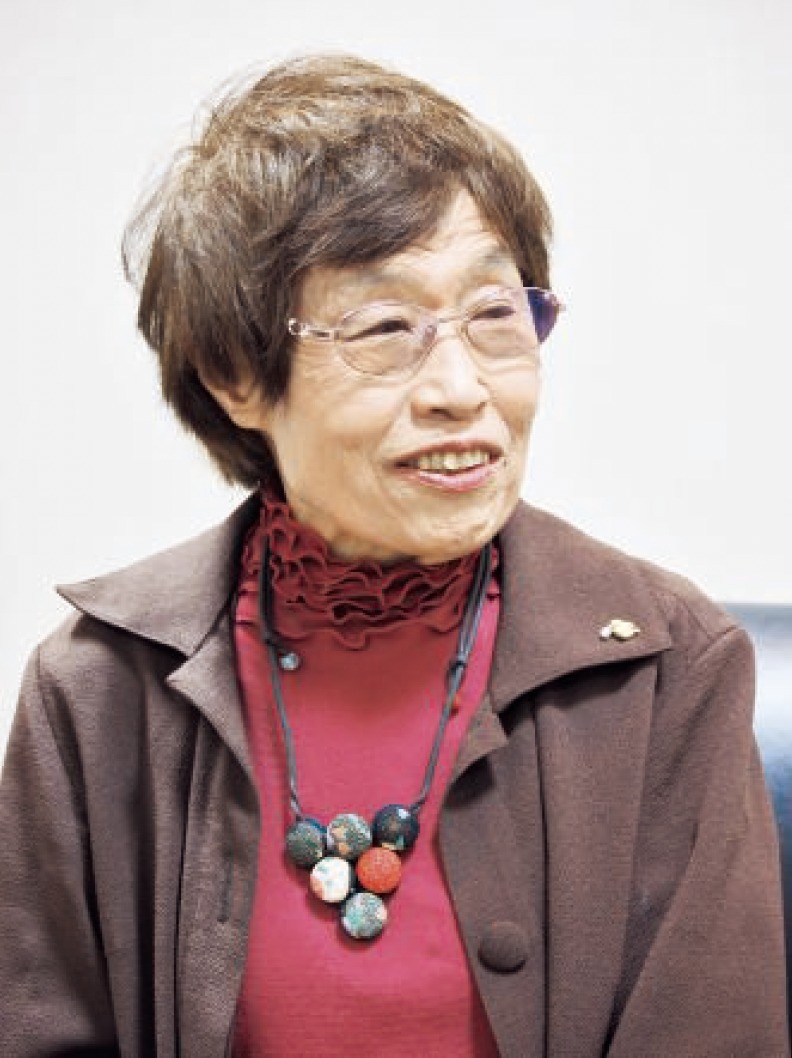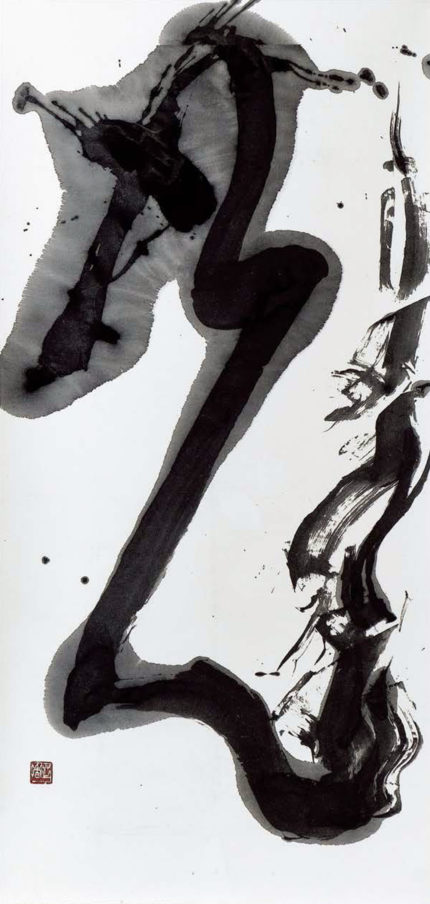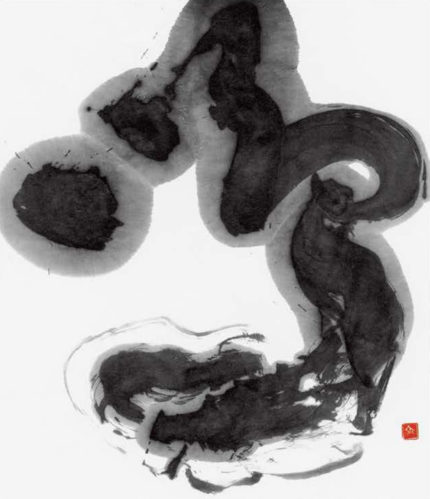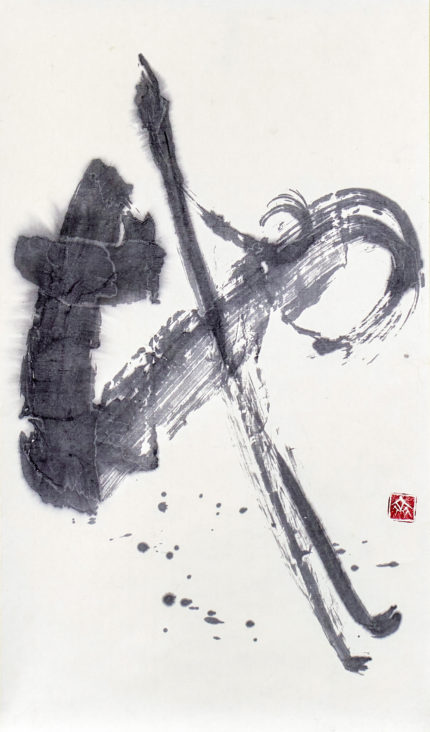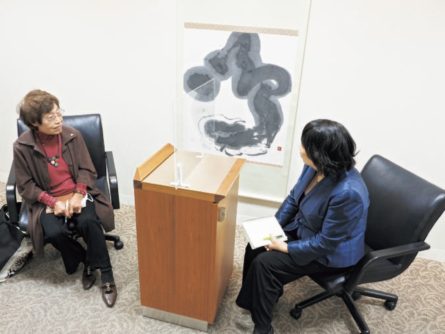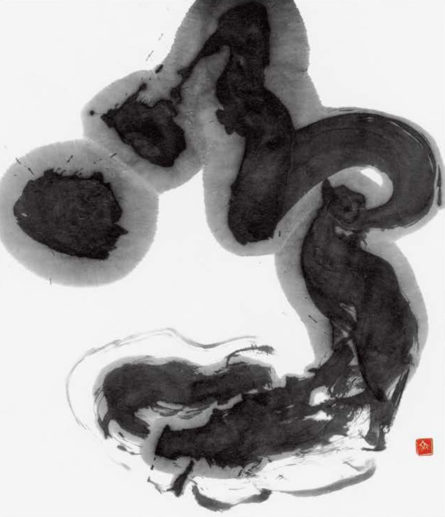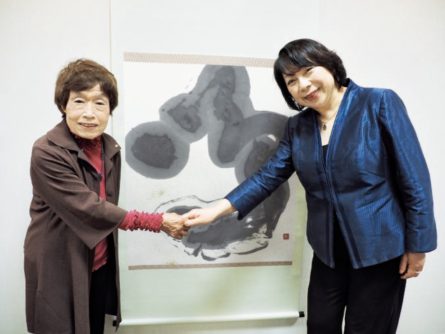- JEPAA Member

- Calligraphy
- Shiko Saito
- 書道
- 齋藤芝香
© 2024 Shiko Saito.
SCROLL
Portfolio /作品一覧
- 光 / Light
- 鳴 / Chirp
- 地 / Groud
Interview article /対談記事
2022年特別対談 齋藤芝香 × ジョセフ・バルバラ

言葉の壁を越える
圧巻の書表現
ジョゼフ・バルバラ(以下 ジョゼフ):齋藤先生の 書は、一つのアートとしていつも興味深く鑑賞してい ました。今日は創作について色々聞きたいと思うので すが、まずは本作のことをお伺いできますか?
齋藤芝香(以下 齋藤):これは地面の「地」を書いたものです。地の漢字にある力強さを表現したくて、とても苦労したことを覚えています。地という漢字は本 来横に広がりがある字なのですが、この作品は縦に長 い作品になっています。思うようにいかずに試行錯誤 していた時、「地」の字の成り立ちを調べてみたんで す。そうしたら、天から神が降り立ったところが大地 になったという意味を知りまして、それで神様が天から降り立ったところを表現してみたら、このような仕 上がりになりました。
ジョゼフ:とても面白い、字の成り立ちの話から表現 へとつながるストーリーは興味深いです。それと線が 魅力的ですね。墨が濃いところと薄いところがありま すが、どのようにすればこんな風に濃淡が表れるので しょうか?
齋藤:腕くらい太い筆に墨をたっぷりつけて書き出す んです。ゆっくり書いているところは太くなり、早くなると掠れたり細くなったりします。
ジョゼフ:その理論で考えると、この作品、最初は ゆっくり、最後は速く書いたということになります ね。その筆使いのスピードの変化には、何か狙いが あったのでしょうか?
齋藤:速く書くと線の中に空気や光が入る余白が生ま れるんですよね。だから文字が立体的になるんですよ。遅いところと速いところを組み合わせると一つの 文字の中に変化が生まれてきます。
ジョゼフ:確かに奥行きがあるように感じますね。上 から下にかけて力の流れを感じます。どんな意味があ るのだろうと考えていたのですが、先生のおかげで謎 が解けました。
齋藤:ありがとうございます。言葉の壁を越えて何か を感じていただけたということは、私にとって大きな喜びです。
ジョゼフ:日本語が印字されている紙や本を見てもフラットな紙にインクが染み込んでいるということしか わかりませんが、このように作品として表現されたも のは立体感や深みが出てとても素晴らしいです。
齋藤:確かに、それが手書きの醍醐味ですよね。その 立体感を表現するためにどれだけ墨をつけるのか、ど んな速さで書くのか。それが少し変わるだけで文字は 変わってきます。墨の中に空気が入るということは光 が入るということなのでそこには最も注意しながら文 字を書いているつもりです。
ジョゼフ:これは漢字を読めない人間が見ても、素晴 らしい芸術作品です。
齋藤:ありがとうございます。書道は文字から成り 立っていますから、文字の意味と雰囲気を作品一つで 汲み取っていただけるのは非常に光栄ですね。特にこ の作品は一字書なのでその言葉はとても嬉しいです。
ジョゼフ:この表装もとても素敵ですね。作品と非常 に調和しています。
齋藤:そうですね、表装一つで作品の印象が変わります。
ジョゼフ:私たちが絵の額を注意深く選ぶのと同じで すね。話は変わりますが、齋藤先生とは以前マルタで お会いしましたね。その時はどのような印象でした か。
齋藤:あの時は娘と孫と行きましたね。とても感激しました。澄んだ海の青さ、空気、島国ならではのマル タの穏やかさどれも鮮明に覚えていますね。本当にい いところでした。
ジョゼフ:一番印象的だったことはありますか?
齋藤:どこからでも海が望めるのが素晴らしいです ね。街中を歩いていても建物の隙間から海が見えて感 動しました。あんな素敵な場所で創作活動ができてい るからこそジョゼフさんの作品は素晴らしいんですね。おとぎの国みたいで素敵ですね。
ジョゼフ:ありがとうございます。以前先生がマルタ で個展ブースをしてくださったこともよく覚えています。マルタの人々にとって日本の芸術はいつでも見ら れるものではありません。だからJEPAA の展覧会が マルタで開催される時は非常に多くの方がお越しくださるのですが、齋藤先生の書はマルタの人たちからも とても好評でした。
齋藤:本当に嬉しいです。言葉の壁を越えて多くの方 に伝わっているのですね。
ジョゼフ:齋藤先生には言葉の壁を越える優れた書の 表現力があります。これからもぜひ素晴らしい書作品 を書き続けてください。今日はありがとうございまし た。
2022 Special Talk Session Shiko Saito × Josef Barbara
Great Written Expressions that Transcend the Language Gap
Joseph Barbara: I have always had a great interest in your works as a form of art. Today I’d like to ask you some things about your process, and I’d like to ask about this piece to begin.
Shiko Saito: This is the character “地” from “地 面.” I remember wanting to express the power of this character, and the significant effort it took. The character “ 地” usually has some horizontal breadth to it, but here I’ve made it thin and tall. After some trial and error since things weren’t going as I’d hoped, I researched how the character came about. I learned the gods came down from the heavens and where he touched down became Earth. This painting is my attempt to render that scene of him coming down from the heavens.
Joseph: Fascinating! It’s interesting to hear how you arrived at painting something that began from a story about a character’s origin. By the way, the lines here are very nice. The ink is thick in some parts and thin in others. How did you achieve this kind of gradation?
Saito: I use a brush about as thick as my arm, get lots of ink on it, and go. The ink is thicker where I went slowly, growing thinner as I speed up.
Joseph: In that case, it would appear that you started off slowly and ended up going fast. Is there some reason why you change the speed of your brushstrokes?
Saito: Going fast creates white space in the lines where air and light can get in. That’s what gives the character three-dimensional depth. Combining slow strokes with quick strokes creates changes in the character.
Joseph: The character does indeed appear to have depth. You can sense the flow of energy from top to bottom. I was wondering about the meaning behind it, and now you’ve solved that mystery.
Saito: Thank you. It’s a great pleasure for me that you were able to get something from it despite the language.
Joseph: When looking at Japanese on a piece of paper or in a book, one might only just see ink absorbed into flat paper. But when one sees an artistic expression like this, the characters take on a wonderful solidity and depth.
Saito: That is the true charm of handwritten characters, I think. How much ink to use and how fast to move the brush to achieve that depth. Even little changes with those things change the character. Letting air into the ink means letting in light, so that’s what I focus on most when drawing the characters.
Joseph: This is a wonderful piece of art, even for those who can’t read kanji.
Saito: Thank you. Calligraphy is all about the characters, so it’s a great honor that you can appreciate both the characters’ meaning and atmosphere in the same piece. Your words make me even happier with this piece since it is only a single character.
Joseph: This mounting is also lovely. It goes very nicely with the piece.
Saito: Yes, even the frame can change the feeling of a piece.
Joseph: That’s why we’re so careful to choose the right frame for our paintings. By the way, you and I met in Malta, right? What did you think of the place?
Saito: I went with my daughter and grandson that time. It was an amazing experience. I vividly remember those clear blue waters, that air. It had a tranquility you can only feel on an island. It is a truly wonderful place.
Joseph: What do you remember about it most?
Saito: It was amazing how you could see the ocean from anywhere. Walking through town, you could see the ocean from between the buildings. Your works are made all the more marvelous because you get to make them in such a lovely place. It’s like some wonderful fairyland.
Joseph: Thank you. I still remember the solo exhibition you ran in Malta. It’s not every day that Maltese people get to see Japanese art. That’s why so many people come when the JEPAA holds an exhibition in Malta. People there liked your pieces a lot.
Saito: I’m so happy to hear that. I guess my art is reaching many people across the language gap. Joseph: Your calligraphy has a wonderful ability to bridge the language gap. I hope you continue to make wonderful pieces like this. Thank you for talking with me today.
2022年特別対談 齋藤芝香 × ゲルマー・トモコ
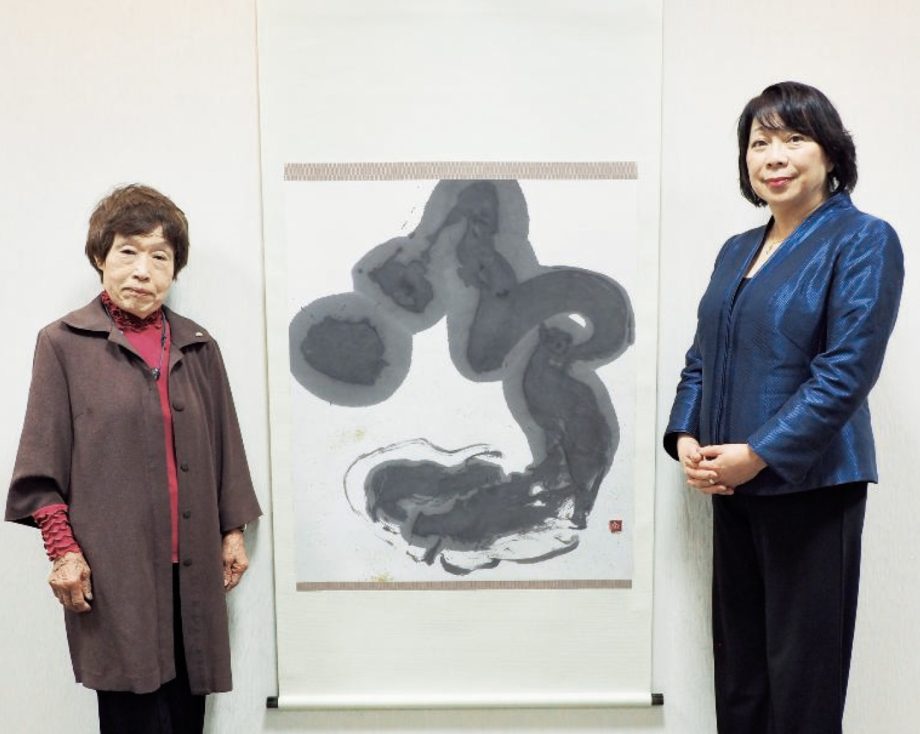
一瞬の感動が紙上を躍動する圧巻の精神表現
齋藤芝香(以下 齋藤):あの時はお世話になりました。おかげさまでとても楽しかったです。
ゲルマー:マルタ展の後も、齋藤先生の作品にはずっと注目させていただいておりました。今日はぜひ、先生に書をご紹介いただければと思うのですが。
齋藤:今回池袋に出展している「鳴」という作品は、もう書いてから10年近く経ちます。これは中日書道会か独立書道会で出品した作品なのですが、今回改めて出展するために軸装し直しました。私の家には大きな楠が2本ありまして、そこに小鳥がたくさん集まってくるんですが、それが可愛いんですよ。それに木漏れ日がすごく綺麗でしてね、この素晴らしい景色を書で表現できないかと試行錯誤して出来上がったのが、この「鳴」なんです。
齋藤:はい、その金粉は後から付け足したものなんですが、楽しい感じを演出したかったんですよ。気づいていただけて嬉しいです。
ゲルマー:お話を聞いていると、齋藤先生はご自身の感情やその表現についてとても大事になさっているのだなと感じます。
齋藤:感じたその瞬間を形にするということは非常に表現できる気がしています。心が躍動して魂がほとばしる時ほどいい字だと感じられますね。上手に書こうと思うとどうしてもできなくなってしまう。だから、しっかり作品を準備した時に限ってあまり納得できる作品は書けなかったりします。むしろふと思い立った時に書いたものの方が良い仕上がりになるんです。そういう時って、何かしら感動があったりするんですが、やっぱり気持ちも乗るんですよね。
ゲルマー:感動が何よりも大切ですよね。私もフルートで思いのまま演奏した時の方がいい演奏ができるということを経験しているので、先生のおっしゃっていることがすごくわかります。
齋藤:雑念を振り払うことが大切っていうのは、どんな芸術表現でも一緒なのかもしれませんね。
ゲルマー:齋藤先生の書は海外の方にも大変好評なのですが、しっかりと感動を表現されているからだと思います。もちろん外国の方ですから、漢字を読むことは難しいです。でも先生の作品は、ご自身の感動や目にした情景を線によって置き換えてくれます。海外の方々は、先生の線の造形の美しさや、そのように表現した意図をテーマと比較しながら楽しんでくれています。感動を文字によって表現するというと、詩や和歌も同じですね。齋藤先生は、文芸を意識されることはありますか?
齋藤:実を言いますと、もともと書道より俳句とか短歌の方に関心があったんですよ。ただ高校生の時に石川雲鶴先生の作品を見て、衝撃を受けたんです。表現が立体的で、字が空気を孕んでいるといいますか、息を吸っているといいますか。本当に「字が生きている」ように感じました。書道を始めようと思ったのは、その時からですね。
ゲルマー:その齋藤先生が、今は書で多くの人に驚きを与えています。運命の巡り合わせというのは、誰に もわかりませんね。おかげさまで書道はドイツでも非常に人気があります。齋藤先生はドイツにどのような印象をお持ちですか。
齋藤:ドイツは一度行ってみたいですね。とても堅実で環境に対して意識が高いとお伺いしております。
ゲルマー:確かに堅実ですし、物を大切にする方は若い子でも多いです。流行というよりも自分が気に入っている物を長く大切にするという方が多いような気がします。
齋藤:日本人もすぐ新しいものではなく、長く大切にする気持ちをドイツから学ばないといけないですね。 ゲルマー:しかし日本の若い子達も、書道を学校でしている方が多いと聞きます。伝統の文化を継承しているのは素晴らしいですね。 齋藤:文化を繋いでいくというのは大切です。ちなみにゲルマーさんは小さい時からフルートをされているんですか。
ゲルマー:私が始めたのは中学の時ですね。小学生の頃はピアノをやっておりました。
齋藤:私も少しだけやったことがありますが、とても難しいです。
ゲルマー:ただ吹いて音を出す楽器なので声に近いというか、自然な音を出すことができますね。
齋藤:ゲルマーさんは、自分の気持ちを音で表現できていると思われますか?
ゲルマー:なかなか難しいですね。ただ長年演奏していると、「表現できている」と確信できるような一瞬に出会うことがあります。そういう時って、瞬間的に解き放たれるような心境になるんですよね。
齋藤:書を書いている時と似ているんですね。私も書をやっていると、そんな瞬間が訪れることがあります。その瞬間があるからこそ、書を続けられていると思います。音楽と書道、道は違っても辿り着く場所は一緒なのかもしれません。
ゲルマー:そうですね、先生と表現の喜びを共有できて、私は嬉しいです。ところで最近は、コロナもだいぶ落ち着いてきました。徐々に世界中の芸術家の動きも活発化していくでしょうが、齋藤先生はこれから何か取り組みたいことなどありますか?
齋藤:私の書のイメージをガラッと変えるような字を書いてみたいですね。それから、今後も変わらず全力投球で臨んでいきたいです。
ゲルマー:さらにエネルギッシュに制作をしていただければと思います。本日はありがとうございました。
齋藤:本当にありがとうございました。楽しかったです。
2022 Special Talk Session Shiko Saito × Tomoko Germar
A Spectacular Spiritual Expression in Which a Moment of Deep Emotional Movement Comes Alive on Paper
Shiko Saito: Thank you for having me back then. It was a lot of fun, thanks to you.
Germar: Even after the exhibition in Malta,I continued to keep an eye on your works.Today, I would like you to show me your calligraphy.
Saito: It’s been nearly ten years since I wrote the piece titled “Chirp” that is now being exhibited at Ikebukuro. This piece was exhibited either at the Chubu Nihon Shodoukai Association or the Dokuritsu Shojindan Foundation, but I remounted it on a scroll to exhibit it again this time. At my house, I have two large camphor trees. Many small birds gather around them, which I find to be cute. The sunlight that filters through the trees is also beautiful. In an effort to somehow depict this wonderful scenery in calligraphy, I ended up writing “Chirp” after some trial and error.
Saito: It’s a beautiful and fun piece. There’s a particularly glittery shine to it. Was this created with gold dust?
Germar: Yes, the gold dust was an afterthought. I added it since I wanted to create a fun feel. I’m glad you noticed.
Saito: When I listen to you speak, I feel that you place great importance on your feelings and how you express them.
Saito: Deep emotional movement is more important than anything else. I’ve also had the experienced where I was able to play the flute better when I played freely, so I very much understand what you’re saying.
Germar: Shaking off distracting thoughts may be universally important in any artistic expression.
Saito: Your calligraphy is also very popular with people overseas, and I think it’s because you express your deep emotional movement so well. Since they’re foreigners, they, of course, find it difficult to read the Chinese characters. However, in your pieces, your deep emotional movement and the scenes you’ve witnessed are depicted through brush strokes. People overseas enjoy comparing the beauty of the shape of your lines and the intention in the way you’ve expressed them with the theme of your pieces. Modern and classic Japanese poetry are also the same when it comes to expressing deep emotional movement through words. Do you ever consciously think about literature?
Germar: To tell you the truth, I was originally more interested in haiku and tanka poetry than calligraphy. But when I was in high school, I saw the calligraphy work of Unkaku Ishikawa and was shocked. The expression through his brush strokes was three-dimensional, and his characters were filled with air, or rather appeared to be breathing. It really felt like the “characters were alive.” It was during this time that I decided to start doing calligraphy.
Saito: That high-schooler you were back then is now surprising many people with his calligraphy. No one knows what a stroke of fate will bring. Thanks to you, calligraphy is very popular in Germany, too. Could you tell me what your impression of Germany is?
Germar: I’d like to go to Germany one time. I hear that the people there are very reliable and environmentally conscious.
Saito: It’s true that Germany has reliable people and many youths who cherish things. I feel that there are many people in Germany who cherish the things they like for a long time rather than what is trendy.
Germar: Japanese people should also learn from Germans how to cherish things for a long time rather than consuming things that are new.
Saito: However, I hear that many young Japanese children are doing calligraphy at school. It’s great that they’re keeping the traditional culture alive. Preserving culture is important. By the way, have you been playing the flute since you were a child?
Germar: I started when I was in junior high school. I used to play the piano during elementary school.
Saito: I’ve also done a little bit of that, but it’s very difficult.
Germar: The flute is an instrument that makes a sound when it’s blown into, so it’s able to create a sound that is close to the voice or is natural.
Saito: Do you think you’re able to express your feelings through sounds?
Germar: It’s quite difficult. But after playing for many years, there are times when I come across a moment when I’m convinced that “I’m expressing myself”. At times like that, I mentally feel a sense of momentary release.
Germar: That’s right. Well, I’m happy that I’m able to share the joy of expression with you. By the way, the COVID-19 pandemic has settled quite a lot these days. The movements of artists around the world will gradually become more active. So, is there anything that you would like to work on in the future?
Saito: I want to write characters that completely change the image of my calligraphy. Going forward, I would like to put my all into this.
Germar: I hope that you will create pieces of calligraphy that are even more energetic. Thank you very much for your time today.
Saito: Thank you for having me. It was fun.
(2022 Special Talk Session: Shiko Saito × Germar Tomoko)
Solo Exhibition /個展
特設個展ブースin 日欧宮殿芸術祭2024
会期:2024年4月20日~22日
会場:シャルロッテンブルク宮殿オランジュリー(ドイツ)
主催:一般社団法人 日欧宮殿芸術協会
運営:クリエイト・アイエムエス株式会社
Solo Exhibition in JEPAA Festival 2024
Date: April 20th – 22th, 2024
Venue: Charlottenburg Palace, Berlin, Germany
Organizer: Japan-Europe Palace Art Association
Operated by: Create IMS Co., Ltd.
Profile /経歴
齋藤芝香 Shiko Saito
1935年生まれ
独立書人団会員
作品出展国遍歴(JEPAA関連事業):ドイツ、フランス、マルタ共和国など
Born:1935,Japan
Affiliate Group: Dokuritsu Shojindan Foundation
Exhibition of Works(JEPAA): Germany,France,Malta…

